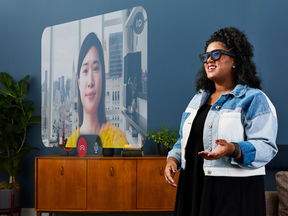And other tech news you can use

Billed as “the most advanced pair of AR (augmented reality) glasses ever made,” Meta took the wraps off Orion on Wednesday, fusing the look and feel of a regular pair of (albeit thick-rimmed) spectacles with plenty of high-tech smarts.
Opposed to virtual reality (VR), which completely closes you off to the real world, AR lets you see the world around you but superimposes digital information on top.
As demonstrated on stage by Meta CEO Mark Zuckerberg at its Meta Connect 2024 event, these AR glasses enable you to do things such as: engage in video calls with friends, family, or colleagues (perceived as 3D hologram-like avatars); look at groceries on a kitchen counter and it will list recipes you can make with them; play immersive and interactive games using your hands in the air; stream movies on what appears to be an enormous screen (perfect for air travel); or use your voice to generate images that pop up in front of your field of view (via Meta AI).
In other words, it blends the physical with the digital.
Orion’s input system combines voice, eye gaze and hand tracking through a special wristband (that resembles an activity tracker) so you can swipe, scroll and click through content. While wireless, a small “compute puck” must be nearby for Orion to work, which lifts some of the processing power off the glasses (and helps extend battery life).

Currently only a prototype, select Meta employees have been testing the device, as well as “select external audiences.” Meta says they plan on shopping “in the near future.”
But for the 2024 holiday season, Meta announced Meta Quest 3S, a mixed reality headset (VR and AR) with the same 4K resolution as the current Meta Quest 3 headset, and supporting all the same apps and games, but at a lower price point.
Starting at $399 Canadian (for 128GB of storage), preorders are available now for Meta Quest 3S and will be on store shelves by Oct. 15. The upcoming game Batman: Arkham Shadow will be bundled with the purchase of any Meta Quest device.
HP ADDS ‘AI PRINTING’ TO SIMPLIFY TASKS
Down the street from Meta’s event in Menlo Park, Calif. was HP Imagine at HP’s Palo Alto headquarters, the second annual media gathering to get some hands-on time with new products and services.
Yours truly was in attendance.
Along with the latest “AI PCs” designed to help you get more done in less time, and with greater privacy than “cloud”-based solutions (like ChatGPT and Google Gemini), HP also showed off how artificial intelligence can improve the printing process – a universal pain point for computer users.
“HP Print AI” is a suite of tools to help iron out printing tasks for consumers and businesses alike, including one handy feature called Perfect Output. As the name suggests, when you want to print something from the web – where more than half of all print jobs come from, says HP – it can print exactly what you want and not banner ads, unnecessary white spaces or images too big or small.
Acting like a browser plug-in, Perfect Output is a button you click and shows you a preview of whatever you’re about to print, such as a recipe, news article, or travel document. The AI magic will automatically reformat the page to what it thinks you want and removes what you don’t, but you can tweak its suggestion before you click “Print.”
The demos worked well, and should save time, frustration, and ink.
You don’t need an HP PC, but you will need an HP printer. Available now in beta (not final software) to “select customers,” it should be available to the mainstream into 2025.

A TRIP DOWN MEMORY LANE AT HP GARAGE
Speaking of HP, a highlight of HP Imagine was a trip to 367 Addison Avenue in Palo Alto, the original home of HP founders Bill Hewlett and David Packard, when the Stanford grads moved in by 1938 (actually, newly married Dave and Lucile lived in the home, while Bill slept in a shed in the backyard).
Considered the “birthplace of Silicon Valey,” it was in fact the 12×18-foot garage (beside Bill’s shed) where many inventions were created, tested and built – beginning with audio oscillators.
An early customer was Walt Disney Studios, where eight machines were purchased to test the film’s theatrical sound ahead of the breakthrough 1940 film Fantasia.
Several inventions were created since then – with none as iconic as the first HP desktop PC for the home in 1980, the HP-85.
Fun fact: Hewlett and Packard came up with their name over a coin toss. Had Packard won the flip, we may be using PH computers today. (Doesn’t have the same ring to it, does it?)
The HP Garage is now a private museum.

ZELDA: THIS GIRL’S GOT GAME
Link, sit this one out.
Nintendo’s latest installment in The Legend of Zelda series, Echoes of Wisdom, stars Princess Zelda in the leading role.
The heroine learns of rifts that have opened throughout the kingdom of Hyrule, with citizens being taken through these portals – and Link, who is missing, may be one of them.
This Nintendo Switch title has Zelda team up with the mysterious fairylike sidekick, Tri, who together leverage the Tri Rod to defeat enemies, solve puzzles, and forge ahead. Much of the gameplay focuses on this magical Tri Rod used to create “echoes,” replications of things you find in the world, to advance through the single-player and dungeon-filled story.
And yes, she may wield Link’s legendary sword from time to time, too.
The Legend of Zelda: Echoes of Wisdom costs $79 and is rated “Everyone 10+” by the Entertainment Software Rating Board (ESRB) for fantasy violence.